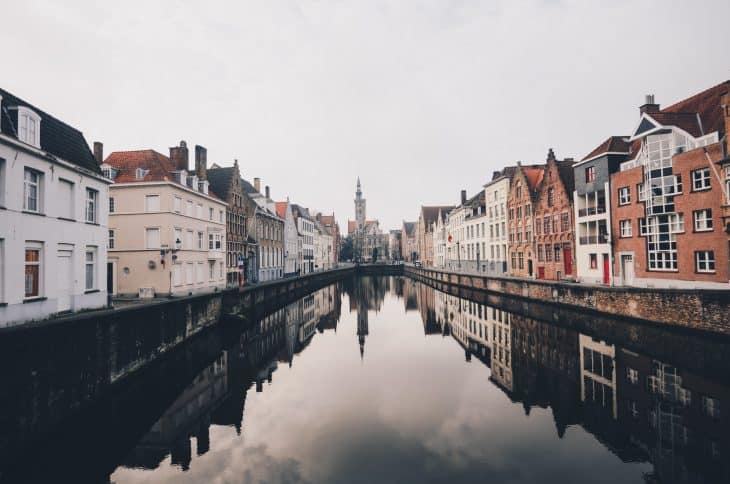
Beer, chocolate, and waffles may be the three things Belgium is famed for. But there’s more to Belgium than just good food, like the country’s history, its culture, and its achievements in sports. Even when we talk about Belgian food and drink, there’s more to it than just beer, chocolate, and waffles. Read on to find out more about Belgium Facts.
- Belgium has a total area of about 30,689 km².
- Water makes up about 6% of Belgium’s total area.
- Belgium’s population is currently estimated at around 11.5 million people.
- There are 376 people for every square kilometer of Belgian soil.
- Belgium falls in the GMT+1 timezone.
- The Belgian Revolution of 1830 gave birth to the modern Belgian nation.
- Leopold I became the first King of Belgium on July 21, 1831.
- Belgium gained the Congo as a colony in Africa in 1885.
- Germany’s invasion of Belgium in 1914 caused Britain to enter WWI.
- Germany invaded Belgium again in 1940, during WWII.
- The Allies liberated Belgium from Germany in February 1945.
- Belgium joined the North Atlantic Treaty Organization (NATO) at its founding in 1949.
- King Leopold III abdicated in 1951 after allegations of collaboration with the Germans in WWII.
- Belgium joined the European Economic Community (EEC) at its founding in 1957.
- Belgium lost its colony of the Congo in 1960.
- Half of Belgium’s estimated 41,000 civilian death in WWII died in the Holocaust for their Jewish faith.
- Belgium’s capital and largest city is Brussels, with an estimated population of 80,000 people.
- Belgians speak 1 or more of 3 official languages: French, Dutch, or German.
- Flanders in the north and Wallonia in the south make up Belgium’s biggest regions.
- Belgium currently ranks as the 18th safest and most peaceful country in the world.
Belgium Facts Infographics

Belgium’s official name is the Kingdom of Belgium.
Here’s a royal example of Belgium facts to start off with. Belgium has had 7 kings ever since the founding of their nation. The 7th and current King of Belgium is Philippe of the House of Belgium and has reigned since his father’s abdication in 2013.
Julius Caesar first used the word ‘Belgium’ during his conquest of Gaul in the 1st Century BC.
He derived the word from a confederation of tribes living across the north of the region. The tribes called themselves the Belgae, and the land they lived in actually included much of what is now Northern France. After the Roman conquest, the Romans then organized their lands into the new Roman provinces of Gallia Belgica and Germania Inferior. Talk about historic Belgium Facts.
The Franks conquered Belgium during the fall of the Roman Empire.
This took place during the 4th and 5th centuries AD, as the Western Roman Empire collapsed from a variety of internal and external factors. Invasions by tribes of Germanic barbarians count as one of those external factors, with the region of Gaul overrun by the Frankish tribes. As the empire collapsed, the Franks in what is now Belgium settled down and mixed with the Romanized local population.
Several former kingdoms ruled over what is now Belgium in the Early Middle Ages.
The Merovingian Kingdom became the first of those, in the 5th century AD. The Merovingians already ruled over what is now Northern France, and it became only natural they expanded to surrounding areas. The Merovingian collapse in the 8th century AD led to the rise of the Carolingian Empire, which counted what is now Belgium as their territory. After the Carolingian Empire collapsed in the early-9th Century AD, most of what is now Belgium became the Kingdom of Lotharingia. The rest became part of West Francia, which eventually evolved into the Kingdom of France.
West Francia briefly gained control of what is now Belgium.
This resulted from the Treaty of Meersen of 870 AD, under which all of what is now modern Belgium became part of West Francia. This lasted until 880 AD when the Holy Roman Empire took control of Lotharingia in the Treaty of Ribemont.
The Holy Roman Empire ruled over Belgium and surrounding areas until the 17th century.
The Eighty Years War from 1568 to 1648 caused a major change in the region. The United Provinces rose in the north, in what is now the Netherlands. And to the south, the Southern Netherlands came into existence in what is now Belgium. Over the following decades, it found itself passing back and forth between the Austrian and Spanish branches of the Habsburg Dynasty.
France fought several wars over the region over the 17th and 18th centuries.
The Franco-Dutch War of 1672 to 1678 became the first of those. Then the Nine Years’ War of 1688 to 1697, the War of the Spanish Succession of 1701 to 1714, and then the War of the Austrian Succession of 1740 to 1748 followed one after the other. Talk about being a coveted piece of land, no matter how we look at it here at Belgium facts.
France gained control of the region towards the end of the 18th century.
This resulted from the 1794 Campaign of the First French Republic, during the French Revolution. France continued to control the region under Napoleon’s First French Empire, only losing them with Napoleon’s defeat in 1814.
The Dutch ruled Belgium for over a decade after Napoleon’s fall.
Belgium gained independence from the Dutch in 1830. Under the Treaty of London, nations recognized the independence of Belgium. They are Great Britain, France, Austria, Prussia, and the Netherlands.
King Leopold II of Belgium brutally ruled the Belgian colony of the Congo from 1885 to 1908.
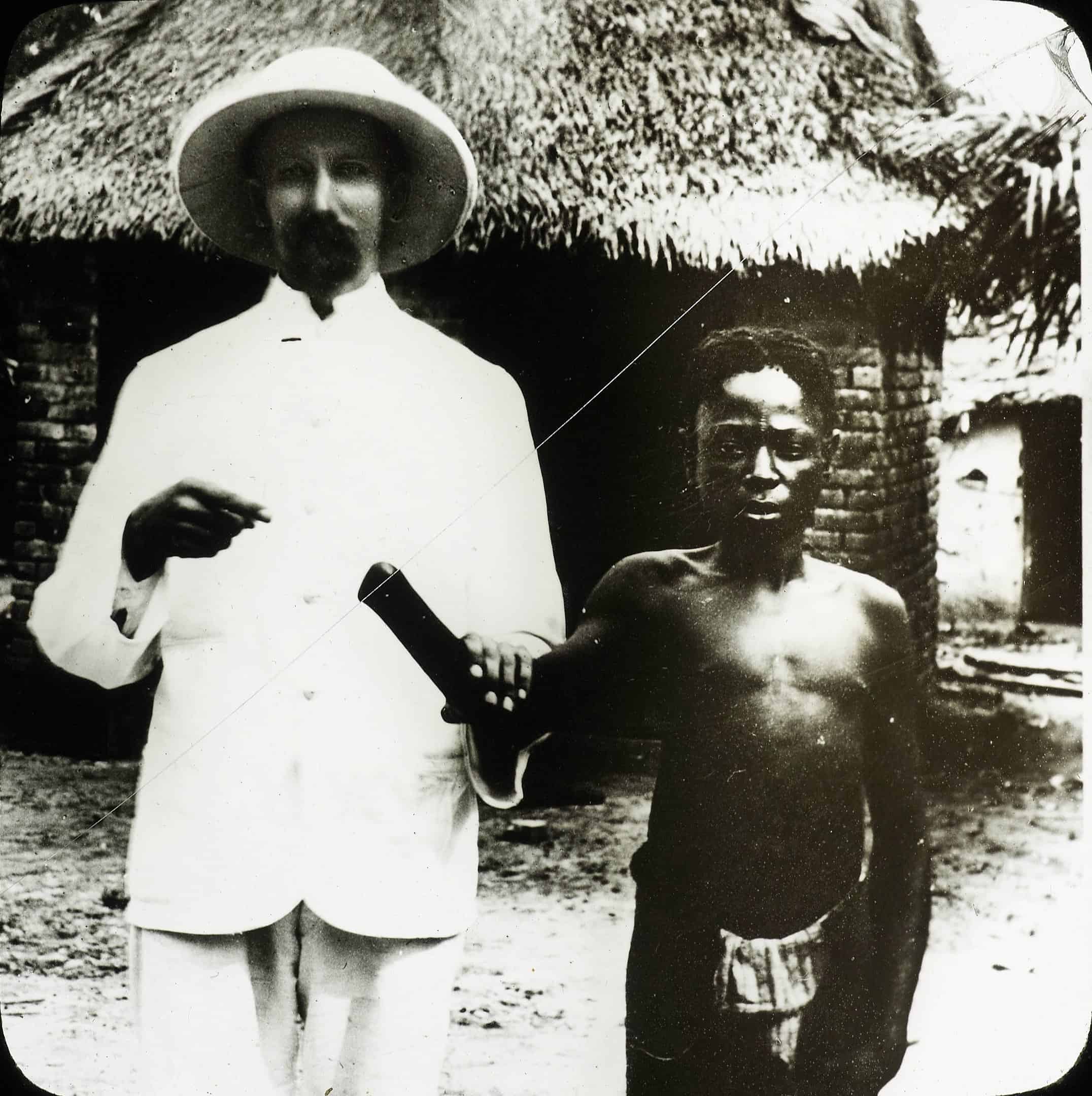
Here’s an example of Belgium Facts that everyone should know about, and never forget. Leopold II directly ruled the colony, instead of placing it under government oversight. Leopold II then forced the native Congolese into forced labor, primarily to work rubber plantations. Others worked in mines or build infrastructures such as roads and bridges. Not only did they little to no pay, failure to work or obey resulted in corporal punishment, usually having a hand chopped off. After international media broke the news in 1908, the embarrassed Belgian government forced the king to surrender the colony to government management.
Belgium gained land from Germany after WWI.
Specifically, Eupen-Malmedy, as compensation for the German invasion of Belgium during World War 1. Under Belgian rule, they became referred to as the East Cantons or East Belgium. Germany tried to regain them during WWII, but after the war, they remained part of Belgium to the present day.
Belgium’s capital of Brussels is home for many international organizations.
These include NATO, founded in 1949, and which Belgium actually helped found. Other international organizations based in Brussels include the European Commission, the Council of the European Union, and the European Council. It also shares the privilege of hosting the European Parliament with Strasbourg in France. Talk about international examples of Belgium facts.
Belgium shares its borders with four countries.
To the south of Belgium is France, with a 556 km shared border. Then there’s Luxembourg, to Belgium’s southeast with 130 km of shared border. Germany is to Belgium’s northeast, with 133 km shared border and finally, the Netherlands in its North, with 478 km of shared border.
Belgium has three main geographical features.
One of those is the coastal plain facing the North Sea, which rises inland into the Central Plateau and the Ardennes Uplands. In addition to these main geographic features, part of the Paris Basin extends into Belgian territory. This is to the south, in the Belgian Lorraine.
Belgium enjoys a temperate climate.
This means Belgium has 4 seasons per year, spring, summer, autumn, and winter. Belgium also enjoys mild temperatures, the lowest usually averaging at 3 degrees Celsius in January. The temperature peaks in July, usually averaging at 18 degrees Celsius. Rain and snowfall averages also averages between 54 mm in late winter to early spring, and 78 mm in summer.
Belgium imports a large number of raw materials.
These raw materials then get fed into Belgium industries for manufacturing useful goods. Raw materials include ore, chemicals, uncut diamonds and other gemstones, medical supplies, food, as well as oil. The resulting exportable goods include machines and equipment, processed food, refined metals, and metal products, even jewelry.
The Industrial Revolution actually began in Belgium.
Well, on the continent anyway, spreading from Britain across the English. In particular, the cities of Liege and Charleroi in Wallonia became major centers of mining and metallurgical production. In fact, the Sambre and Meuse River Valleys stayed among the most important industrial centers in the world until the middle of the 20th Century. Industrialization didn’t come without a cost though, a cost paid in the form of a general decline in the textile industry of the Flanders region to the north.
Flanders bounced back in the latter part of the 20th century.
The process actually began as early as the end of WWII and speeding up in the late-20th century. In particular, the expansion of the oil and chemical industries brought new wealth to the previously-neglected region. Ghent and Antwerp in Flanders especially profited from this development, though the Oil Crisis in the 1970s caused a major recession. After it passed though, Flanders’ economy continued to improve, while Wallonia’s economy declined. Today, Flanders is the center of the Belgian economy.
Belgium suffers from some of the worst traffic jams in the world.
Statistics show that individual commuters can spend between 64 to 65 hours per year waiting in traffic jams. And it’s not just on the ground. 80% of all of Belgium’s flights have to go through a single airport, Brussels Airport. Similarly, 80% of all of Belgium’s maritime trade passes through only 2 ports, Antwerp and Bruges. Antwerp, in particular, handles over 200 million tons of shipping per year based on statistics. Talk about congested examples of Belgium facts.
Many famous scientists in history came from Belgium.
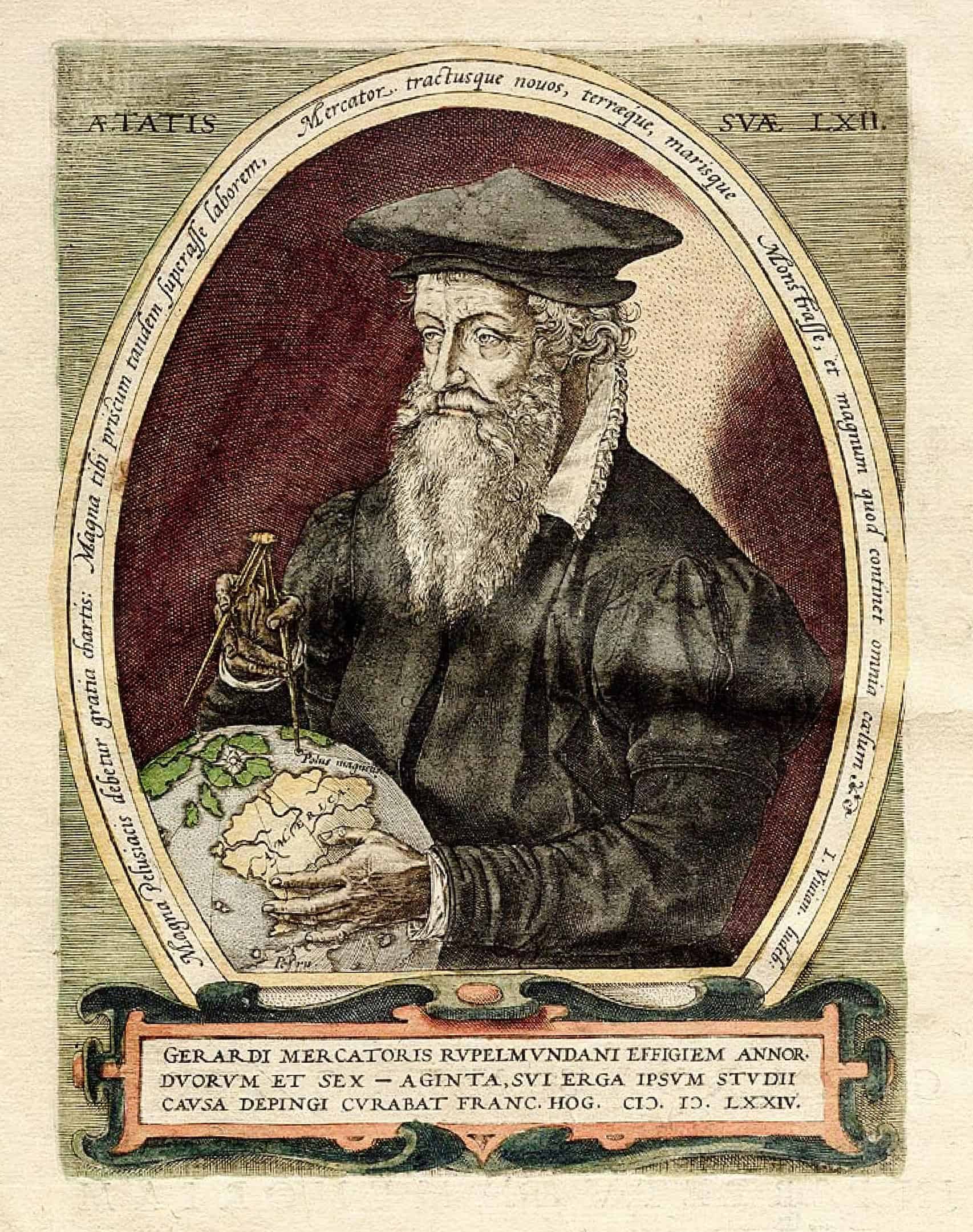
These include Gerardus Mercator, a 16th Century geographer and mapmaker who pioneered the development of the first modern maps. Another famous historical Belgian is Andreas Vesalius, a 16th Century doctor who refused to depend on classical texts from Greece and Rome. Instead, Vesalius conducted his own research, even becoming the first man to dissect human corpses to learn about how the human body worked, and thus pioneered the modern field of anatomy.
In the 19th century, the chemist Ernest Solvay pioneered the industrial production of sodium carbonate. Similarly, the engineer Zenobe Gramme developed one of the first electrical generators. Another Belgian, Leo Baekelite, produced the first plastic in the early-20th century. It was even a Belgian priest, Georges Lemaitre, who first theorized the Big Bang in the early-20th century.
A Belgian cartoonist was behind The Adventures of Tintin.
The Adventures of Tintin is one of the most famous comic book series from the 20th century. Written by Georges Remi, or as he preferred, Herge, this series focused on the adventures of the reporter Tintin, accompanied by his group of friends and his pet dog, Snowy. Originally published in the 1930s, by the end of the 20th century, the Adventures of Tintin had sold over 200 million copies in over 70 languages. Adaptations in film, radio, theater, and TV, had also successfully aired by then.
Belgian cuisine reflects the country’s international character.
A popular saying about Belgian cuisine is that it includes the amount served in German cuisine while having the quality of French cuisine. More commonly, though, Belgium cuisine is most famous when it comes to beer, chocolate, and waffles.
Belgian cuisine incorporates several common ingredients.
These include asparagus, beer, leeks, potatoes, and shrimp. Common staples include butter, cheese, and meat of several different varieties.
Belgians usually eat four distinct meals in a single day.
They start off with breakfast, of course, and usually a light one at that. They then have a medium lunch, later followed by a snack to fight off hunger pangs. Finally, Belgians finish off the day with a heavy dinner.
French fries might actually have come from Belgium.
Here’s a surprising example of Belgium facts. Historians believe this is because the Americans first called the dish French fries because the Belgian soldiers who showed them the dish spoke French. Historical evidence actually shows fried potatoes first mentioned in 1781. Even then, said evidence actually points to the people of Namur in Wallonia making fried potatoes even further back, to 1680.
Belgian fries have their own dedicated restaurants in Belgium.
That, or they’re sold at street-side stands and carts as snacks to passers-by. They’re even served on their own, smaller servings wrapped in paper rolled into a cone. Larger servings, for practicality’s sake, get served on trays. Either way, Belgian fries always come with a serving of sauce on top. Now there’s a tasty example of Belgium facts.
Belgian fries are also served with other snacks.
These include frikandel, a minced meat sausage that also inspired the modern hotdog. Other snacks that get served with Belgian fries include traditional meatballs called gehaktbal, and croquettes. Yet another tasty example of Belgium facts.
Belgian fries sometimes also come included in a sandwich called a mitraillette.

Also known as a submarine gun, the mitraillette is a loaded baguette, stuffed with meat and fries, and topped with different kinds of sauce. Mitraillettes are commonly served in friteries and cafes in Belgium. The original version used to contain only sausage or sliced meat, however different kinds of meat are now used, where every friterie has its own version now.
Sauces for Belgian fries come in a wide variety.
Ketchup and mayonnaise are the most popular, of course. But they aren’t the only sauces used for Belgian Fries either. Aioli is another popular sauce, made from garlic, olive oil, and salt. Another popular sauce is Sauce Americaine, made from brandy, butter, Cayenne pepper, fish stock, onions, salt, tomatoes, and white wine. There’s also Bearnaise Sauce, made from egg yolks, onions, white wine vinegar, and various herbs.
Belgium has the most varieties of beer out of any country in the world.
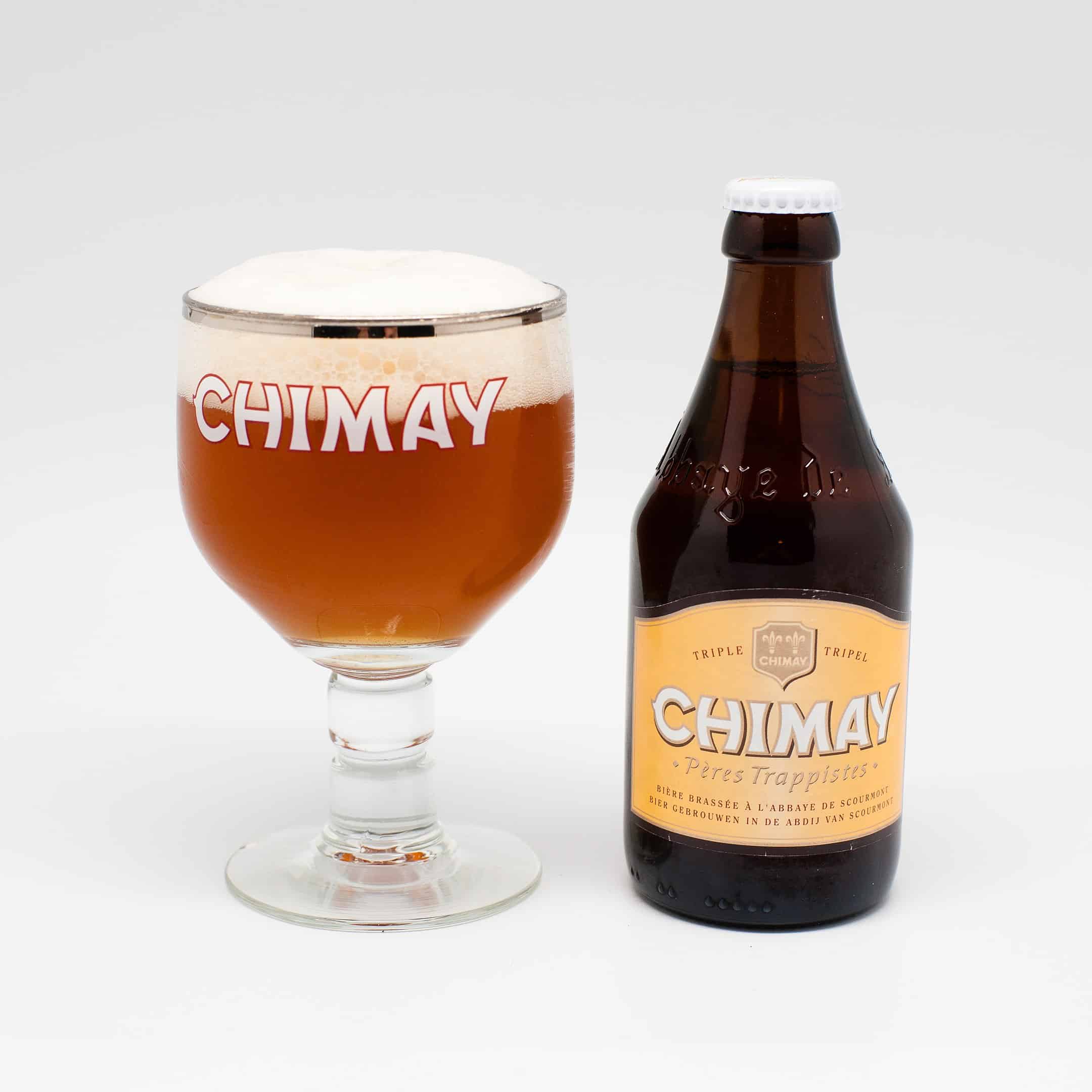
There are currently 1,132 varieties of beer in Belgium today. Belgium’s beer-making tradition goes back to the Early Middle Ages, with the 6 monasteries of the Order of the Cistercians of the Strict Observance among the oldest beer-makers in the country. On average, statistics show that Belgians drink up to 157 liters of beer in a single year.
Beer is also used to make cheese.
This is actually a specialty of the Order of the Cistercians of the Strict Observance’s monastery at Chimay. Instead of salt water, they wash cheese with beer, giving their cheese a distinct flavor. This process is known as the à la bière method. Talk about a classy and tasty example of Belgium facts.
Belgians also use beer in their cooking.
One common example is wheat beer, used in cooking seafood. Blonde beers are used for cooking eels, as well as chicken and other kinds of white meat. Similarly, dark beers are used to cook dark meat, while fruity beers are often used in desserts.
Several traditional Belgian dishes use beer as an ingredient.
One signature dish is carbonade, a beef and onion stew, which uses beer as the base for the sauce. The kind of beer used in this dish depends on the region, with Antwerp carbonade using De Koninck beer.
Jenever is Belgium’s national spirit.
The Jenever (or Genever) is so important to Belgium’s culture and national identity, that the European Union gave it special protection. Specifically, the manufacturing of Jenever can only take place in Belgium itself, and in specially-designated areas in France and Germany.
Belgian chocolate comes in many varieties.
With over 2000 varieties, in fact, the Belgian chocolates are born with a tradition that goes back to the 17th century, when Spain ruled the country. As Spain at the time ruled over large parts of Central and South America as colonies, they introduced chocolate to Europe from the New World. Chocolate became extremely popular since mid 18th century onward, under Austrian rule. In particular, Charles Alexander of Lorraine went down in history for his love of hot chocolate.
Chocolate is a major export of Belgium.
The raw material for making chocolate usually comes from Africa, and they are processed in Belgium for export. Statistics show that Belgium exports an estimated 172,000 tons of chocolate every year. Now that’s a lot of chocolate, no matter how we see it here at Belgium facts.
Belgium heavily regulates the production of chocolate in the country.
The Belgian government reinforces regulations to ensure the quality of the product, given the importance of chocolate to the Belgian economy, and its place in Belgian history and culture. One such regulation is all chocolate products must include at least 35% pure cocoa, while another regulation is a complete prohibition on the use of vegetable fats in making chocolate.
Most Belgian chocolate remain handmade to the present day.
These include the renowned brands Neuhaus and Guylian. This tradition of hand-making chocolate is one of the contributing factors to the high prices of Belgian chocolate. And for the same reason, tourists often flock to chocolate shops when visiting Belgium to get these handmade chocolates.
Chocolate only needs one qualifier to be named Belgian chocolate.

This comes as something of a surprise, considering the otherwise heavy regulation of the chocolate industry in Belgium. That is, true Belgian chocolates have to be made in Belgium itself.
Pralines are a common kind of Belgian chocolate.
Pralines are hard chocolate shells with a soft filling in the center. Fillings come in many flavors, such as caramel, cherries, coffee, and liquor among others. The chocolate shell itself comes in many shapes and sizes, but usually in the form of shrimp and other aquatic creatures. How’s that for a sweet example of Belgium facts?
Another common kind of Belgian chocolate is truffles.
Belgian chocolate truffles come in many forms. Most commonly they come in round shapes, either smooth or flaky, with a creamy filling whose ingredients are often kept secret by the producer. Other truffles come in the form of wafers crusted with chocolate or even just cocoa powder.
Côte d'Or is the biggest manufacturer of Belgian chocolates in the world.
They make around 1.3 million chocolate bars and an estimated 2 million chocolate toffees in a single day. Belgians consume about 200 million Côte d’Or products per year and much more gets exported and consumed around the world.
The company’s name is French, which means Gold Coast, the old name for what is now Ghana. The name originates from how Ghana provides most of the cocoa used by the company to make chocolate with.
Belgian folklore also reflects its international culture.
Each Belgian region celebrates its own distinct festivals, unique to the region rather than to the country as a whole. Apart from that, there are also several shared cultural celebrations nationwide, such as Easter.
The most popular of Belgian festivals is the Carnival of Binche.
The Carnival of Binche is one of the biggest events in Belgium, that preparations usually start one year in advance. Held in the town of Binche in Wallonia, the main celebration takes place over three days immediately before Ash Wednesday.
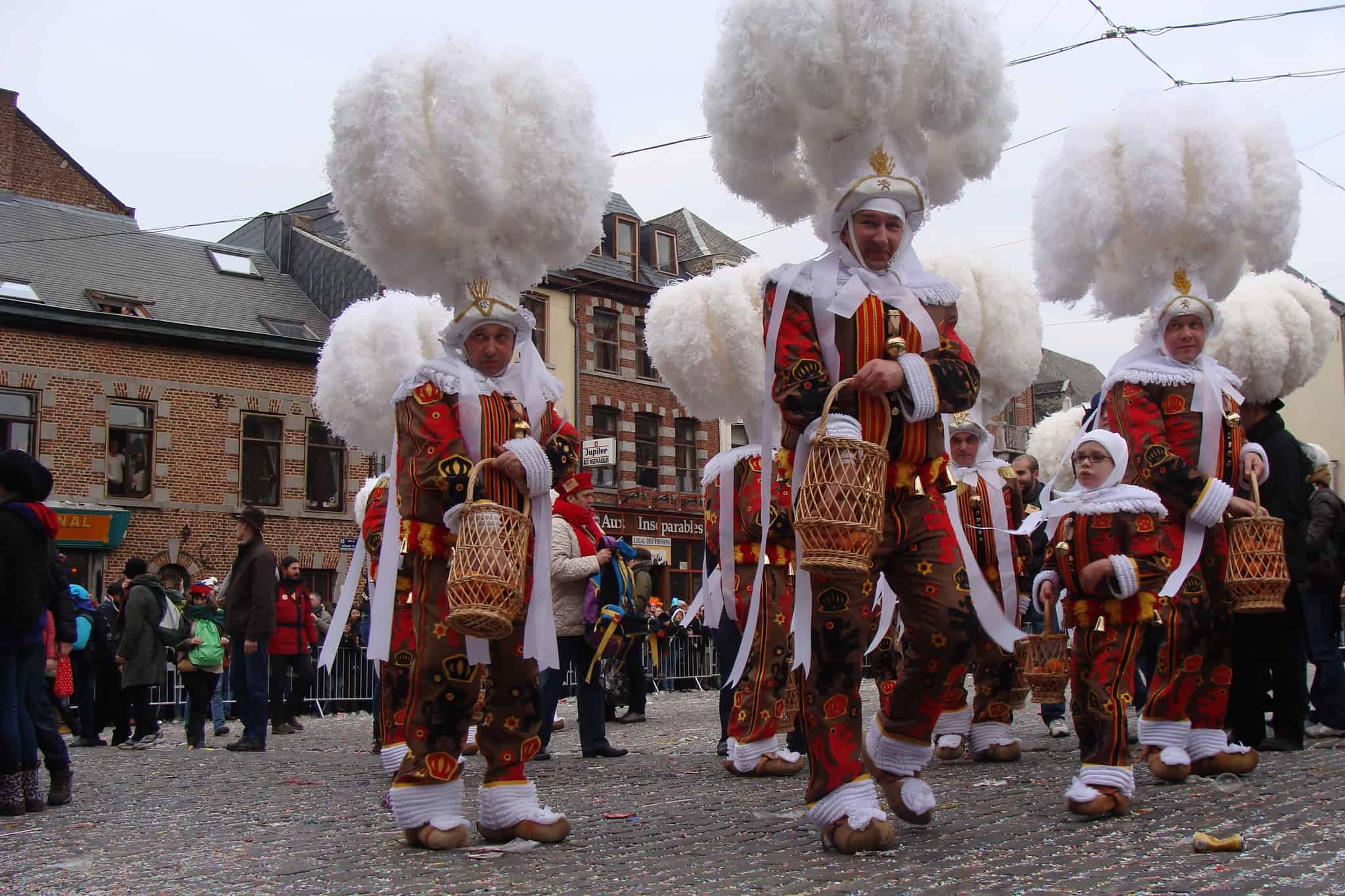
Musical and dancing events, as well as marches, happen over 7 weeks leading up to Ash Wednesday. During the main celebration, clown-like figures called Gilles march through the town, dancing and playing drums to scare away evil spirits. Gilles are selected from local men, between the ages of 3 to 60. If you’re one of the selected Gilles, it is considered a great honor.
During the parade, Gilles throw oranges at their surroundings and audience, traditionally to invoke good luck. However, to throw an orange back at the Gilles is nothing less than an insult.
The Carnival of Binche is a historical legacy.
This celebration goes back to the 14th century, in fact. UNESCO has even named the festival a Masterpiece of the Oral and Intangible Heritage of Humanity. That said, it’s not the only festival that takes place in the Wallonia region of Belgium. Talk about a historic example of Belgium facts.
Ath in Belgium also has a famous festival of their own.
Also found in Wallonia, Ath holds the Parade of Giants every summer. Like the Carnival of Binche, the history of the Parade of Giants goes back to the Middle Ages. The festival celebrates the marriage of 2 giants, Monsieur and Madame Gouyasse, starting with a mock ceremony in a church. After the wedding, Monsieur Gouyasse fights David in front of the church, referencing the Biblical legend of David and Goliath. Afterward, the parade marches across the town.
The Bear Festival is another well-known Belgian festival.
The town of Andenne in Wallonia hosts this festival, held every year 3 weeks before Easter. It celebrates the memory of Charles Martel, who killed a bear terrorizing the region in the 8th century. On average, around 2000 people celebrate the festival every year, while the town hall hands out teddy bears to passersby.
The Blanc Moussis festival has an interesting twist as part of its celebration.
Festival participants begin their procession wearing white sheets and hoods, with long-nosed masks. It celebrates the monks of the 15th century, who weren’t allowed to participate in carnivals of the time.
During the festival, they go around town putting up posters and then parade through the town while throwing confetti, along with the interesting twist of the festival. Specifically, in addition to throwing confetti at people, participants also hit bystanders with dried pork bladders.
Wallonia isn’t the only region of Belgium to celebrate annual festivals.
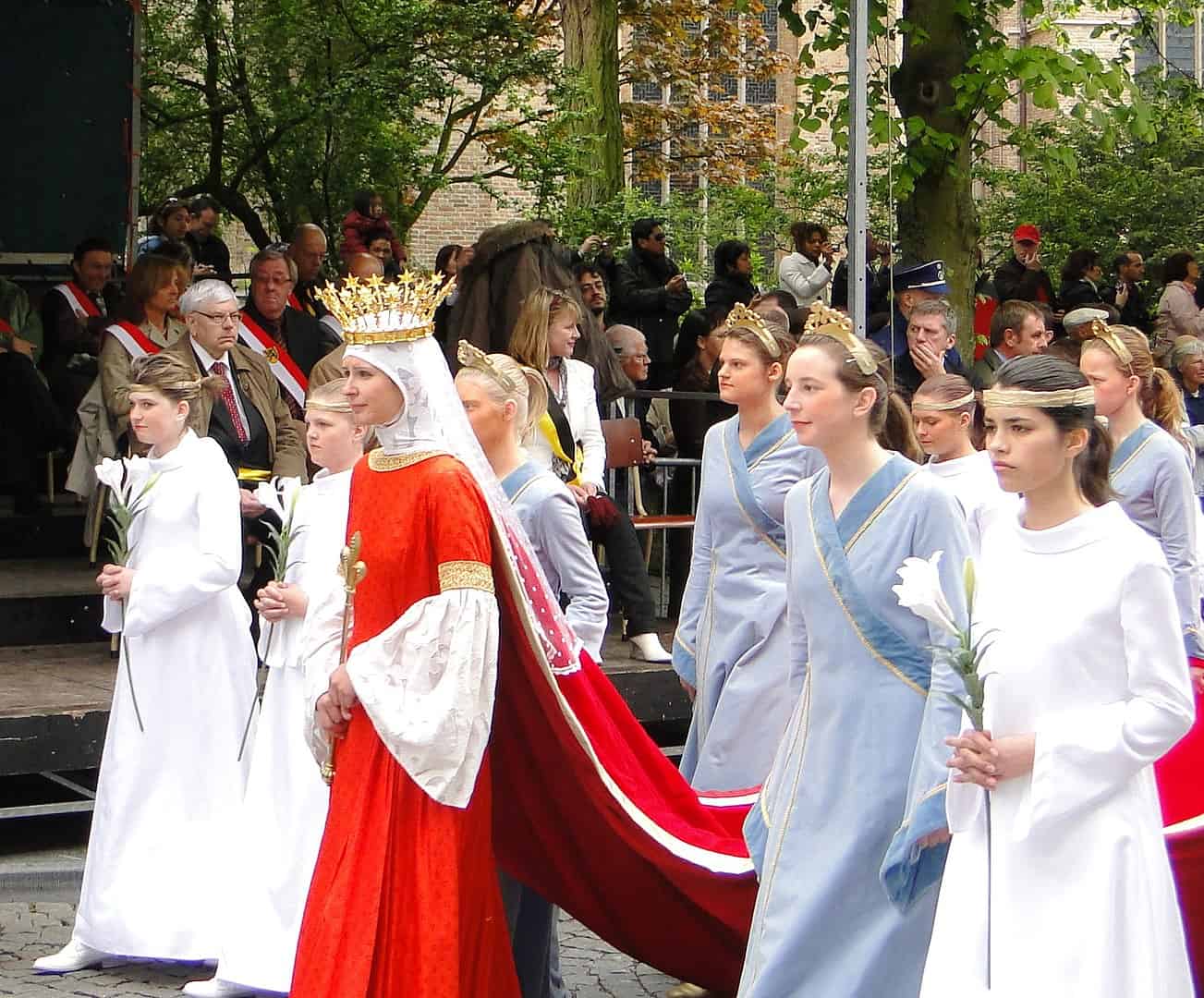
One of the biggest festivals in Flanders is the Procession of the Holy Blood, held every year on Ascension Sunday. During the festival, a vial of rock crystal said to hold the blood of Christ gets paraded around the city. Over 50,000 tourists and pilgrims attend the festival around the year.
A similar festival is the Procession of Penitents in Veurne, held on the last Sunday of July. Reenactments of the Passion of Christ take place, along with penitents parading in hoods or carrying crosses of their own.
Ypres once held a rather grisly festival.
The Cat Festival takes place on the second Sunday of May, celebrated with the throwing of cats from the church tower. This symbolizes the people’s abandonment of pagan traditions in favor of Christian teachings. The grisly part comes from how before modern times, live cats were actually thrown from the church to die after falling to the ground. Thankfully, today cat-shaped toys and dolls have replaced live cats during the festival.
The municipalities north of Antwerp have a curious game called goose-riding.
No, they don’t actually ride geese, they ride horses. It’s called goose-riding because of the goal of the game. Once every year, each village suspends a dead goose over the ground in a fishing net. The participants try to pull off the dead goose’s head, with the one who succeeds then getting crowned as the king of the village for the year. Once all villages have a king, the kings hold a second competition, with the winner then getting crowned emperor of the villages for the year.
Brussels has its own unique annual festival.
The Ommegang of Brussels is a modern recreation of traditional medieval pageants and takes place twice a year. It is usually held at the beginning of June, and the beginning of July. In addition, the festival recreates and commemorates the arrival of Emperor Charles V and his son, the future King Philip II of Spain, in Brussels in 1549.
Sports are big in Belgium.
Statistics actually show over 17,000 sports clubs of all kinds in Belgium, with a membership of around 1.4 million. All in all, approximately 13% of the Belgian people officially participate in one sport or another. Popular sports in Belgium include basketball, cycling, judo, tennis, and volleyball.
Football is one of the biggest sports in Belgium.
Belgium actually helped found FIFA in 1904, though it took until 2015 for the Belgian National Football Team to get 1st Place on FIFA’s World Rankings. They also managed to reach 3rd place during the 2018 FIFA World Cup.
Outside of FIFA, Belgium hosted the 1972 European Football Championship and co-hosted the 2000 European Football Championship. Belgian goalkeeper Jean-Marie Pfaff is also regarded as the greatest goalkeeper in the history of football.
Belgium also enjoys a strong track record at the Olympics.
Over the history of the Olympic Games, Belgium has won a total of 41 Gold medals, 55 Silver medals, and 58 Bronze medals in the summer games. In the winter games, Belgium has won only 1 Silver medal, back in the 1948 Winter Olympics.
Hockey is another major sport in Belgium.
Belgium’s Men’s National Field Hockey team, also known as the Red Lions, is currently ranked 1st in the world. Whereas, the Women’s National Field Hockey team, also known as the Red Panthers, currently ranks at 11th place.
Belgium is also a major contender in the Tour de France.
The Tour de France is a multiple-stage bike race held across France but sometimes passes through parts of surrounding countries. Participants can come from any country, but France naturally dominates. That said, Belgian cyclists come the closest to matching France’s lead, with 18 Belgian champions to 36 French champions.
Belgian cyclist Eddy Merckx is the greatest cyclist of all time.
The title comes from his unmatched record of wins, including 11 Grand Tours, with 5 victories in the Tour de France. He also won 5 victories in the Tour de Italy, and once in the Tour de Spain. Other victories of Eddy Merckx include all the Monument races, 3 world championships, the hour record, and many more.
All in all, Merckx achieved a total of 525 victories, earning him the nickname the Cannibal for not letting anyone else win. Talk about historic and sporting examples of Belgium facts.
A famous Belgian racer is Jacky Ickx.
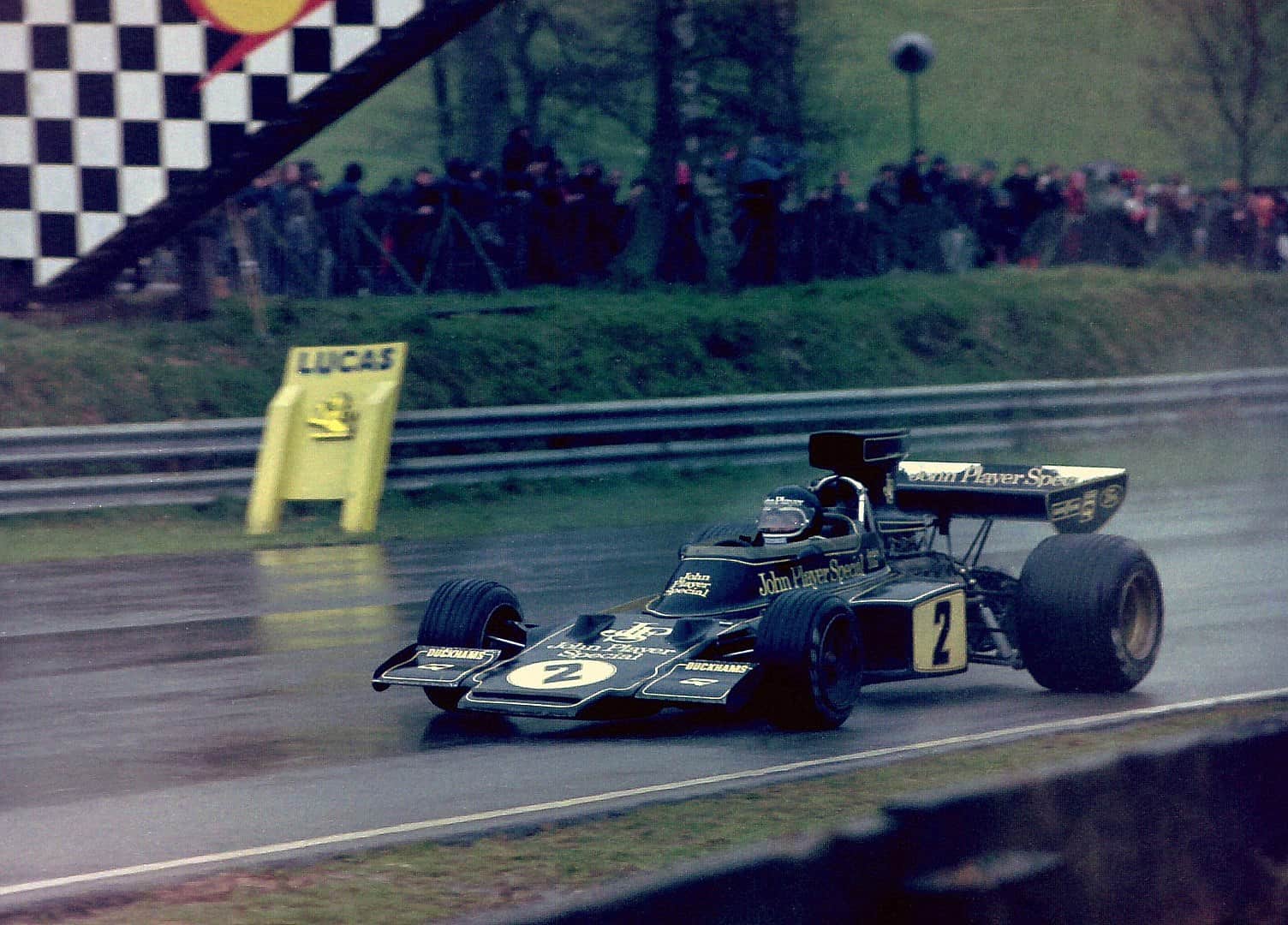
His record includes 5 victories at the Grand Prix and another 6 victories at the 24 Hours of Le Mans. He also finished twice as the first runner-up in the Formula One World Championships.
Several sporting events take place in Belgium every year.
These include Memorial Van Damme and the Belgian Grand Prix Formula One. Other sporting events include the Tour de Flanders, as well as the Liege-Bastogne-Liege cycling race.
Was this page helpful?
Our commitment to delivering trustworthy and engaging content is at the heart of what we do. Each fact on our site is contributed by real users like you, bringing a wealth of diverse insights and information. To ensure the highest standards of accuracy and reliability, our dedicated editors meticulously review each submission. This process guarantees that the facts we share are not only fascinating but also credible. Trust in our commitment to quality and authenticity as you explore and learn with us.
